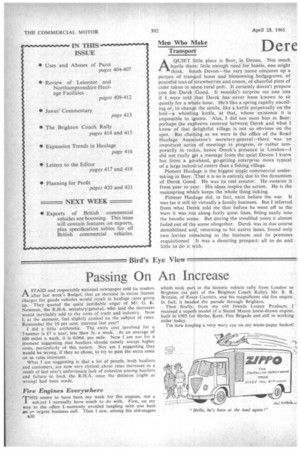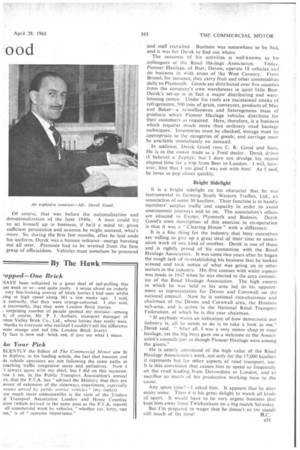Passing On An Increase
Page 34

Page 35

If you've noticed an error in this article please click here to report it so we can fix it.
ASTAID and respectable national newspaper told its readers after last week's Budget, that an increase in excise licence charges for goods vehicles would result in haulage rates going up. They quoted the quite justifiable anger of Mr. G. K. Newman, the R.H.A. secretary-general, who said the increases would inevitably add to the costs of trade and industry. Now I, at the moment, feel slightly cynical on the subject of rates. Remember the 10 per cent. increase last year?
I did a little arithmetic. The extra cost involved for a 7-tonner is £7 a year, less than 3s. a week. At an average of 600 miles a week, it is 0.06d. per mile. Now I am not for a moment suggesting that hauliers should tamely accept higher costs, particularly of this nature. Nor am I suggesting they would be wrong, if they so chose, to try to pass the extra costs on as rates increases.
What I am suggesting is that a lot of people, both hauliers and customers, are now very cynical about rates increases as a result of last year's unfortunate lack of cohesion among hauliers and failure to back the R.H.A. once the decision (right or wrong) had been made.
Fire Engines Everywhere
THIS seems to have been my week for fire engines, not a I subject I normally have much to do with. First, on my way to the office I narrowly avoided tangling with one bent on a" .urgent business call. Then I saw, among the old-stagers
B30
which took part in the historic vehicle rally from London to Brighton (as part of the Brighton Coach Rally), Mr. R. B. Brittain, of Essex Carriers, and his magnificent old fire engine. In fact, it headed the parade through Brighton.
Then finally, from my old friends Lesney Products. I received a superb model of a Shand Mason horse-drawn engine, built in 1905 for Hythe, Kent, Fire Brigade and still in working order today.
I'm now keeping a very wary eye on my waste-paper basket!
-opped—One Brick
HAVE been subjected to a great deal of tail-pulling this ast week or so—and quite justly. I wrote about an orderly very fine-looking convoy of brick lorries I had seen whilst ving at high speed along MI a few weeks ago. I said, te correctly, that they were orange-coloured. I also said, e incorrectly, that they were London Brick lorries.
, surprising number of people spotted my mistake—among n, of course, Mr. P. 1 Authers, transport manager of rston Valley Brick Co., Ltd., whose lorries they really were. thanks to everyone who realized I couldn't tell the difference veen orange and red (the London Brick livery).
ty face is now red brick red, if you see what I mean.
ke Your Pick
ECENTLY the Editor of The Commercial Motor saw fit to deplore, in his leading article, the fact that busmen and ds vehicle operators are not following the same paths in roaching traffic congestion cures and palliatives. Now I 't always agree with my chief, but I did on this occasion. low I see, in the Public Transport Association's annual wt, that the P.T.A. has " advised the Ministry that they are avour of extension of the clearways experiment, especially routes served by public service vehicles" (my italics).
ow much more statesmanlike is the view of the Traders d Transport Association London and Home Counties ision (which arrived in the same post as the P.T.A. report) all commercial work by vehicles, "whether car, lorry, van ,us," is of " supreme importance."
























































































































